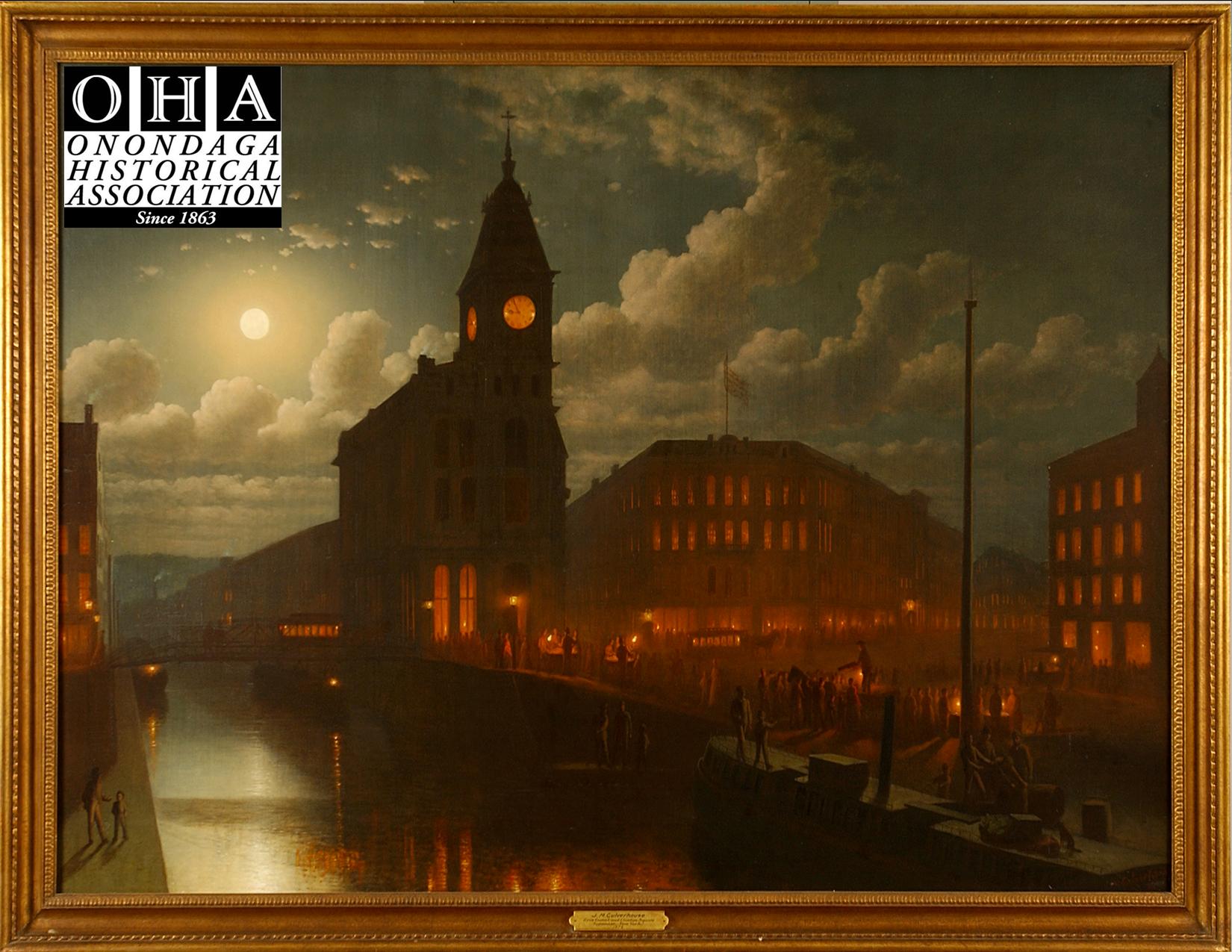
The Artist: Johann Mongales Culverhouse (1849-1891) had a studio in Syracuse for a brief time in the 1870s. The Syracuse Journal for December 12, 1871 reported that he opened a studio in Judson N. Knapp’s art gallery and frame store at 47 Genesee Street, the building is shown in Culverhouse’s painting of Syracuse by moonlight, now titled Clinton Square. He is recorded as being a native of Rotterdm, Holland, though John H. Williams, a New York art dealer, has disputed the fact.
Culverhouse’s life in America is documented mainly by exhibition records and his work. He exhibited at the American Academy of the Fine Arts in 1849, the Boston Athenaeum and the New Jersey Art-Union in 1851, and the National Academy of Design and the Pennsylvania Academy of the Fine Arts in 1852. The American Art-Union in New York acquired and exhibited seven of his paintings in 1849 and distributed them to its subscribers. It sold six more at public auction in 1852 when it was disbanded as an illegal lottery. Culverhouse apparently returned to Europe in the late 1850s. He exhibited at the Paris Salons of 1857, 1859, 1861, 1863, and 1864, giving a Paris address. According to Scheen, he exhibited in Antwerp in 1861 and in Amsterdam the following year. By the mid-1860s, Culverhouse was back in America. He exhibited at the National Academy of Design in 1865 and 1 866, giving a New York address, and at the Pennsylvania Academy of the Fine Arts in 1867. By December 1871 he had settled in Syracuse, New York. Notes from a variety of sources in the collection of the Onondaga Historical Association provide a brief record of his stay there. According to the city directory for 1872, Culverhouse was boarding at the St. Charles Hotel. On May 17th of the same year he offered “a rare lot of paintings” for public auction as he was “about to leave the city.” A lawsuit, however, brought against him by a prominent Syracuse citizen two years later provides evidence that Culverhouse either remained in, or returned to, the city.
Several of Culverhouse’s paintings were shown in the fall exhibition of the Brooklyn Art Association in 1877 and one in the spring of the following year. Although he is said to have died about 1891, the date and place of his death are not known. Judging by his sporadic exhibition record, Culverhouse led a peripatetic life. Perhaps, as has been suggested, he returned to Europe several times. Although he tried to accommodate the American market by painting local scenes, he remained a firm adherent to Dutch traditions. His choice of subjects and the style of his known paintings reflect this European background.
The Painting: In this piece, we are transported back to the years just after the Civil War, and find ourselves gazing at the evening activities of downtown Syracuse from a vantage point much like that atop a boat on the Erie Canal. In front of us stands the original Onondaga Savings Bank (now the Gridley Building; to the right is the Bastable Block (where the State Tower Building is located today), its upper stories lighted perhaps for a performance at Shakespeare Hall. For many, the image rings of nostalgia. However, when it was painted, viewers would probably have commented on how well Culverhouse conveyed the essence of modernity. At the time of this painting, only two years had passed since the Bastable Block stores were introduced to gas lighting. American artists were obsessed with the depiction of light, chiefly during the 1850s and 1860s, a trend that 20th century critics have called Luminism.
The piece was conserved in October 2012 by Mary Betlejeski of the New York State Office of Parks, Recreation, and Historic Preservation at Peebles Island in Waterford, NY.
The painting was part of an exhibition at OHA called The Changing View. The exhibit presented works painted between 1820 and 1950 and were mostly landscapes and townscapes, chiefly by artists with ties to Syracuse or Onondaga County.
How it got to OHA: The piece was purchased by OHA in January of 1962 from Harry Shaw from The Old Print Shop, 150 Lexington Avenue in New York City for $800.
Information used in this post came from the OHA collection and American Paintings in the Metropolitan Museum of Art , Volume II: A Catalog of Works by Artists Born between 1816 and 1845. The latter can be found here.

